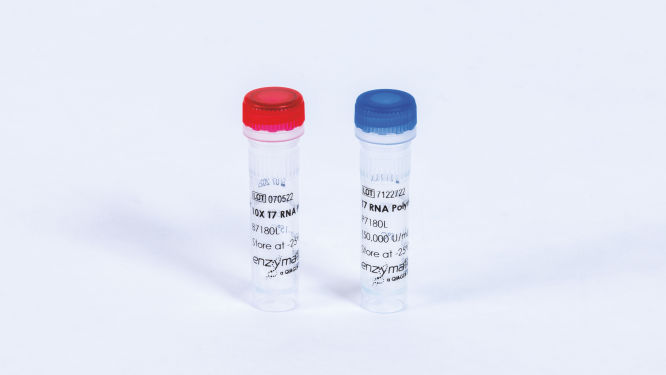Cat. No. / ID: P7180L
Features
- DNA-dependent RNA polymerase
- High specificity for the T7 promoter
- Catalyzes the Mg2+ dependent synthesis of RNA from rNTPs
Product Details
T7 RNA Polymerase provides 5ʹ→ 3ʹ RNA synthesis of RNA from a DNA template. T7 RNA polymerase requires its T7 double-stranded DNA promoter to initiate transcription, but it can transcribe RNA from both single-stranded and double-stranded DNA templates. The enzyme is supplied in 50 mM Tris-HCl, 100 mM NaCl, 1 mM DTT, 0.1 mM EDTA, 50% glycerol and <0.1% Triton X-100; pH 7.9 at 25°C.
10X T7 RNA Polymerase Buffer (B7180) contains 400 mM Tris-HCl, 60 mM MgCl2, 100 mM DTT and 20 mM spermidine; pH 7.9 at 25°C.
Performance
- Storage temperature: –25°C to –15°C
- Molecular weight: 98,855 Daltons
| Test | Units tested | Specification |
|---|---|---|
| Purity | n/a | >99% |
| Specific activity | n/a | 312,500 U/mg |
| Single-stranded exonuclease | 500 U | <1% released |
| Double-stranded exonuclease | 500 U | <1% released |
| Double-stranded endonuclease | 500 U | No conversion |
| E. coli DNA contamination | 500 U | <10 copies |
| RNAse DNA contamination | 500 U | No detectable non-specific RNAse |
Principle
The recombinant enzyme protein is produced by a recombinant E. coli strain carrying the T7 RNA Polymerase gene.
One unit is defined as the amount of enzyme that will incorporate 1 nmol of ATP into acid-precipitable material in 1 hour at 37°C.
Procedure
Usage Instructions
Synthesis of non-labeled RNA
- Set up the following reaction mixture in a total volume of 20 μL:
| Components | Final Concentration |
|---|---|
| Nuclease-free Water | N/A |
| 10X Reaction Buffer (B7180) | 1X |
| rNTP | 500 µM each |
| Template DNA | 0.2-1 µg |
| T7 RNA polymerase (P7180L) | 100 U |
2. Incubate reaction mixture at 37°C for 1 hour.
References:
1. Chamberlin, M. et al. (1973) J. Biol. Chem., 248, 2235-2244, 2245-2250.
2. Chamberlin, M. et al. (1982) in The Enzymes, 3rd edition, ed. P. D. Boyer (Academic Press, New York), 15, 87-108.
3. Sambrook, J. et al. (1989) Cold Spring Harbor Laboratory Press, Molecular Cloning: A Laboratory Manual., (2nd ed.), 5.40-5.43.
Quality Control
Unit activity was measured using a twofold serial dilution method. Dilutions of the enzyme were made in 50% glycerol containing T7 RNA Polymerase storage solution and added to 50 µL reactions containing a T7 promoter-containing plasmid DNA, 1X T7 RNA Polymerase Buffer, 3H-ATP and 400 µM each ATP, GTP, CTP and UTP. Reactions were incubated for 10 minutes at 37°C, placed on ice, and analyzed using the method of Sambrook and Russell (Molecular Cloning, v3, 2001, pp. A8.25-A8.26)
Protein concentration is determined by OD280 absorbance.
Physical purity is evaluated by SDS-PAGE of concentrated and diluted enzyme solutions followed by silver-stain detection. Purity is assessed by comparing the aggregate mass of contaminant bands in the concentrated sample to the band's mass corresponding to the protein of interest in the diluted sample.
Single-stranded exonuclease is determined in a 50 µL reaction containing a radiolabeled single-stranded DNA substrate and 10 µL of enzyme solution incubated for 4 hours at 37°C.
Double-stranded exonuclease activity is determined in a 50 µL reaction containing a radiolabeled double-stranded DNA substrate and 10 µL of enzyme solution incubated for 4 hours at 37°C.
Double-stranded endonuclease activity is determined in a 50 µL reaction containing 0.5 µg of plasmid DNA and 10 µL of enzyme solution incubated for 4 hours at 37°C.
E. coli contamination is evaluated using 5 µL replicate samples of enzyme solution that are denatured and screened in a TaqMan qPCR assay for the presence of contaminating E. coli genomic DNA using oligonucleotide primers corresponding to the 16S rRNA locus.
Non-specific RNAse contamination is assessed using the RNAse Alert kit (Integrated DNA Technologies), following the manufacturer’s guidelines.
Applications
This product is available for molecular biology applications such as:
- RNA synthesis from DNA template
- RNA probe preparation
- mRNA therapeutics

